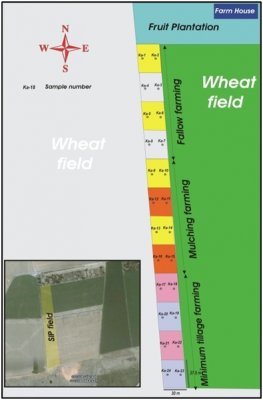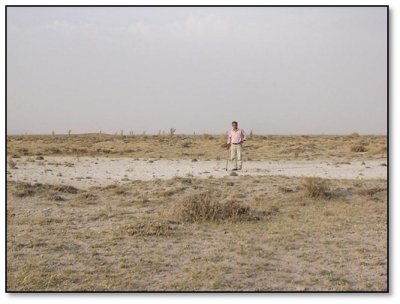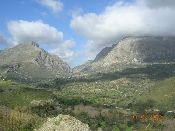|
Minimum tillage: experiment results and conclusions |
 |
|
 |
The Karapinar area is the most arid part of Anatolia in Turkey, which suffers from wind erosion due to unfavorable soil and climatic conditions. Also the area knows intensive use of ground water resources for irrigation. Earlier ground water well measurement showed that annual drop reaches 8-10 m. Farmers mostly prefer cereals, maize and sugar beet as irrigated crop types.
Ploughing often results in fine particles that are removed by the wind. Direct drilling has already been introduced as an alternative. An experiment was carried out to test the effect of minimum tillage and stubble on wheat (Ekiz bread wheat) without irrigation. Sediment moved by wind erosion itself is very difficult to measure so the experiment concentrated on the suitability of these tillage forms.
|
Experiment: minimum tillage and stubble mulching
|
The technologies tested are minimum tillage (MT), stubble fallowing (SF) and ploughed stubble fallowing (PSF), near the settlement of Apak Yayla. They are designed in a strip farming plan on the crop yield of Ekiz bread wheat (Triticum aestivum var. Ekiz). For each technology four rows of parcels perpendicular to the dominant wind direction were made of which one is active this year and other fallowed. The following parameters were measured at the times indicated in the table below.
- Sprouting number /m² and branching number (in the early and late sprouting period)
- Grain yield, number of grains in ear, weight of 1000 grains, height of plant, harvesting index and # of grains in m² (in the harvesting period)
|
 |
 |
Observations are done on two different locations on each parcel and are averaged later. Unfortunately there were no means to measure physical soil parameters but only crop related parameters (yield related). |
Sprouting and branching are used to calculate the density of the wheat plants per m². The three technologies resulted in considerable variations in term of sprouting observations. Minimum tillage has the highest sprouting intensity but lower branching number while the ploughed stubble fallowing is optimum for both sprouting intensity and branching number. The inter-annual variation is high.

Grain yield and height of plant is the best for stubble fallowing while the number of grains in ear and weight of 1000 grains do not considerably vary. In terms of harvesting index and number of grains in m², minimum tillage and stubble fallowing have clear advantages upon ploughed stubble fallowing (see table below).
Income is based on grain and straw yield, whose amount varies significantly according to the technology applied. From the viewpoint of net economic income, the Stubble farming has clear advantage compared to other technologies (Table below) with a net income of %44. The other two technologies are close to each other.

 |
In terms of wind erosion, it was observed that the stubble farming and minimum tillage have less visual wind erosion than the ploughed parcels.There are however no measurements for this. |
 |
The results are evaluated from a production, socio-cultural and economic point of view. The bars express the estimated or measured percentage of change with respect to the reference situation. This change can be positive (blue) or negative (red). Note that this evaluation is based on the experiments, on the long term experience of the coordinating team in this area and on consultations with the farmers.
Both treatments are evaluated at the same time as they are one large experiment.
|
 |
Stakeholders are passively involved in the division of the area into technology parcels and the ploughing and sowing operations as observers. The presumed efficiency and expected results of technologies applied in the field were discussed. The owner of the experimental field executed the agricultural activities himself (ploughing, fertilising, etc.) throughout the season. |
Stakeholders generally approve the effectiveness of the technologies tested. The yileds are comparable although slightly lower. However the treatment includes a fallow period which for the irrigated areas is not present. Thus land is taken out of production which is considered very negative. This is not compensated by the net gain in income of the treatment because of lower labour and operational costs. This will be different for each farmer, depending on the degree of mechanization. The end result is therefore that the technology is not readily accepted because the benefits are not sufficiently clear cut. This may change if irrigating with groundwater becomes too costly. The experiment shows that rainfed agriculture is possible in principle while having a positive effect on wind erosion (at least visually).
|
Minimum tillage and stubble fallowing have clear advantages in terms of yield parametres of the Ekiz bread wheat in Karapinar hotspot. Minimum tillage particularly positively effects the sprouting intensity but not the branching number.
|
|
The variations in yield parametres are probably explained in terms of removal of nutrient topsoil by wind erosion. It seems that minimum tillage and stubble fallowing decrease the shear stress of the wind and hence reduce the wind erosion.
|
|
Contrary to vegetative parameters, the harvested product (both for grains and straw) is the maximum in stubble farming followed by ploughed stubble farming.
|
|
Basic obstacles agains the wider application of technologies are considered the lack of specialised machinery and required knowledge for minimum tillage and the decrease of net income due to fallowed parcel each year.
|
|












